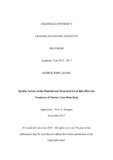JavaScript is disabled for your browser. Some features of this site may not work without it.
| dc.contributor.advisor | Zioupos, Peter | |
| dc.contributor.author | Adams, George John | |
| dc.date.accessioned | 2020-10-30T14:49:01Z | |
| dc.date.available | 2020-10-30T14:49:01Z | |
| dc.date.issued | 2017-09 | |
| dc.identifier.uri | http://dspace.lib.cranfield.ac.uk/handle/1826/15952 | |
| dc.description.abstract | Cancellous bone tissue plays a vitally important role in the strength and mechanical competency of the bone throughout the body. It constitutes a large amount of the bone volume at the axial skeletal sites such as the proximal and distal ends of the femur. Cancellous bone is far less dense than the cortical shell within which it is encapsulated, and in the history of bone research it was first overlooked due in part to this dramatically increased porosity. Over the last few decades however there has been a push to understand the mechanical, structural and chemical properties of the tissue, as degenerative conditions affecting the cancellous tissue such as osteoporosis become more and more prevalent in an ever ageing society. This produces a need for a better clinical assessment of the bone health and strength of patients so that preventive measures can be taken earlier to reduce the risk of fractures, which can be extremely traumatic and sometimes fatal. To achieve a better clinical assessment of cancellous tissue we must first understand the material and structural properties that cause a reduction in the fracture toughness (FT) of the tissue. In the present study there are three separate sections, the first is an investigation into the ability of micro-Computed Tomography (µCT) to assess the structural and density properties of bone tissue. This is achieved by imaging samples from the full spectrum of bone porosities, made possible by excision of an elephant femur, to assess the best methods for thresholding samples to produce data that most accurately matches laboratory measurements and to determine the density relationships that exist across this spectrum. It was found that the material density of bone is in fact non-linear across the full porosity of bone and that bone experiences its highest material density at the extremes of porosity, whilst the softest regions of bone exist in porosities of ~40% The second section is focused on the how the chemical and structural properties of cancellous bone tissue affect its FT. By using the protocols determined in the first section, cancellous bone tissue that had been previously FT tested were imaged, and the morphometric data obtained was analysed to determine what structural properties were impacting the FT. Multilinear regressions were then employed to produce statistical models to predict the FT, these models were able to predict FT with R2 values as high as 0.798. The material level characteristics of the samples were then assessed by means of x-ray diffraction (XRD), infrared spectroscopy (FTIR), Raman Spectroscopy and nano-indentation. This assessment revealed that multiple chemical parameters were highly correlated with the fracture toughness; the parameters that correlated highly were added to the multiple regression models to produce R2 values as high as 0.911 showing a marked improvement over the structural properties alone. These models were produced for samples loaded across and along the primary orientation of the trabecular struts, and for each direction the models contained different contributors marking clear adaptations in bone at the material and structural level to resist fracture in specific orientations. The third and final stage of the study aimed to produce material models that could be utilised in micro-Finite Element (µFE) models to simulate a fracture like event. This was attempted by first µCT imaging bone from a wide array of different densities; the samples were subsequently indented to determine the material properties at the micron level. The indented areas were mapped in the image data to produce models to convert grey values to material level modulus. This modulus was applied to segmented µCT image data, collected from the fracture toughness samples, in µFE simulations. The simulations were then developed further to simulate the fracture by introducing an element softening protocol. This was carried out on five samples, due to limitations of computational time, three of which iii closely matched the previously recorded data. With further development and validation these models may prove to be extremely valuable in the understanding of fracture risk. To conclude, the fracture toughness of cancellous bone tissue is contributed to by a combination of the structural and chemical properties of the tissue. The quantity of bone was found to be the single largest contributor to toughness and with the addition of other structural or chemical properties of the tissue it may be possible to predict the fracture toughness of the tissue which with further work could be translated to an individual’s fracture risk. Additionally the use of µFE simulations in conjunction with material models may with further work be able to predict the fracture risk of an individual. These two approaches will hopefully be able to help in the understanding of cancellous bone fractures to greater inform the fracture risk of those with conditions such as osteoporosis | en_UK |
| dc.language.iso | en | en_UK |
| dc.relation.ispartofseries | PhD;PhD-17-ADAMS | |
| dc.rights | © Cranfield University, 2017. All rights reserved. No part of this publication may be reproduced without the written permission of the copyright holder. | |
| dc.title | Quality factors at the material and structural level that affect the toughness of human cancellous bone | en_UK |
| dc.type | Thesis | en_UK |
